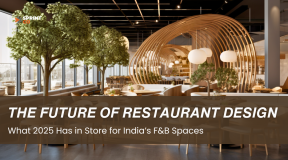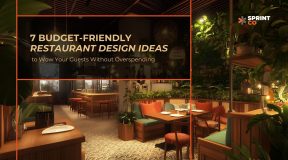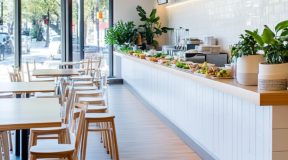Owning a restaurant often brings a flood of questions to mind. What style should your restaurant, café, or bar have? How do you create interiors that are both attractive and functional? Can the infrastructure support your design aspirations? And, most importantly, how can you ensure profitability?

If these questions resonate with you, you’re not alone. Stepping into the realm of restaurant design reveals a world of possibilities and a newfound appreciation for well-thought-out spaces. To achieve the best results, consider partnering with interior designers specializing in restaurant interiors.
Meanwhile, here are some fresh ideas to make your restaurant stand out:
- Design the external façade for maximum visibility
- Incorporate a blend of covered and open ceilings
- Seamlessly integrate indoor and outdoor spaces
- Use flooring to define zones
- Turn walls into storytelling elements
- Enhance ambience with lighting and greenery
- Strategically position the order delivery counter for efficiency
Let’s delve into these ideas in detail to inspire your vision.

1. Make the External Façade Unmissable
Your restaurant’s exterior is more than just an entryway; it’s an invitation. A well-designed façade acts as an extension of your dining experience and a visual advertisement. To ensure maximum visibility, align the façade design with your interiors and signage.
Consider smart outdoor lighting to highlight architectural features, illuminate signage, and brighten any outdoor seating. Keep the front transparent to showcase the interiors, drawing customers in while enhancing the overall appeal.

2. Rethink Ceiling Design
Choosing between a false or raw ceiling? Why not go for a creative combination of both? False ceilings may feel outdated, while entirely raw ceilings are often overdone. A mix of covered and open ceilings can add a unique touch to your space.
Covered sections help conceal services and reduce air-conditioning costs, while open grids or rafters lend character and provide easy access to utilities. This hybrid approach transforms the ceiling into a design statement.

3. Blur the Line Between Interiors and Exteriors
Opening up the restaurant’s front can visually expand the space and create a relaxed, inviting ambience. Use sliding or revolving doors that can be fully opened during pleasant weather, merging the indoor and outdoor areas seamlessly.
For added functionality, extend the bar or service counter outdoors. Install air curtains at the transition points to maintain air-conditioning efficiency and prevent condensation issues.

4. Create Zones with Flooring
Flooring is often overlooked, but it plays a vital role in shaping your restaurant’s vibe. Beyond functionality, it can add a playful or elegant aesthetic.
Use different flooring materials or patterns to define various seating and serving zones. Highlight main aisles with borders or patterns, or use vinyl stickers for storytelling or directional signage. Ensure that the flooring remains practical and safe while elevating the design.

Lighting and greenery
Lighting and greenery add to the mood of the space. Bringing in a splash of green along with warm lights instantly increases the aesthetic value as well as draws more customers. However, energy efficiency should not be compromised with in the quest of giving gram worthy photos to your patrons.
Plants and flowers are a great way to deck up your restaurant. You can switch them whenever you want to. Living walls and vertical gardens have also emerged as major design trends. Not only do rows of lush herbs and greenery create gorgeous visual impact, they can also improve air quality.


5. Let Walls Speak for Themselves
Walls can tell a story—literally. Use them to share your restaurant’s journey, celebrate food, or convey inspiring messages. Typography, murals, decals, and wall art are great tools to make your walls visually engaging.
Contrast colours, exposed textures, and minimalistic treatments can enhance the aesthetics while keeping the space uncluttered, leaving room for creative décor.
6. Enhance the Atmosphere with Lighting and Greenery
Lighting and greenery are powerful tools for setting the mood. Warm lighting paired with greenery instantly boosts the visual appeal and creates an inviting atmosphere. While creating Instagram-worthy spots, prioritize energy-efficient solutions.
Incorporate plants, flowers, or even vertical gardens. Living walls not only make a striking visual impact but also improve air quality, enhancing the overall dining experience.
7. Optimize the Order Delivery Counter
Whether you’re opening a coffee shop, a QSR, or a deli, the location of the delivery counter requires careful consideration. It should be easily accessible, with a clearly defined aisle for smooth customer flow.
A single-line queuing system ensures fairness and efficiency. Visibility is key—positioning the counter strategically can significantly boost sales. Thoughtful planning of this element contributes to operational success.

Conclusion
Designing a restaurant involves countless choices, but incorporating these elements can ensure your space is both unique and functional. From maximizing visibility to crafting a cohesive ambience, these ideas can elevate your restaurant’s appeal. For the best results, enlist the expertise of interior designers who specialize in restaurant design to help bring your vision to life.





